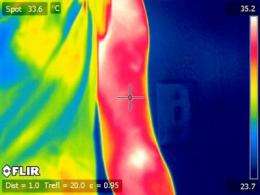Researchers quantify muscle soreness

Quantifying how sore a person is after a long workout is a challenge for doctors and researchers, but scientists from Loma Linda and Asuza Pacific Universities think they may have figured it out. Their research article describing a new technique to measure muscle soreness will be published in the Journal of Visualized Experiments (JoVE).
Delayed onset muscle soreness (DOMS) or exercise-induced muscle damage (EIMD) is one of the most common sports injuries, but without a reliable method of quantifying muscle soreness, assessing treatments is difficult.
Traditionally, muscle soreness has been measured using the visual analogue scale (VAS). Participants mark their level of agreement to a statement along a continuous line. Rather than measuring soreness subjectively, the researchers used thermal imaging to detect subtle changes in the temperature of the skin above exercised muscles.
"The main advantage of this technique," said paper author Dr. Jerrold Petrofsky, "is that unlike visual scales, which are kind of a subjective measure of whether someone is sore or not, this technique gives you quantifiable, absolute data."
"There is no gold standard for measuring DOMS and other techniques, such as needle biopsies, are invasive and painful for patients," said JoVE Editor, Leiam Colbert. "The technique presented here allows for earlier diagnosis and quicker treatment of soreness."















